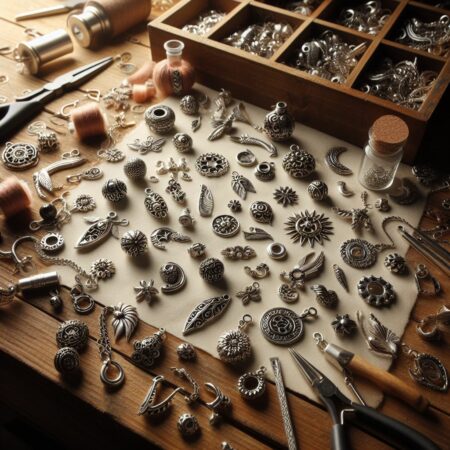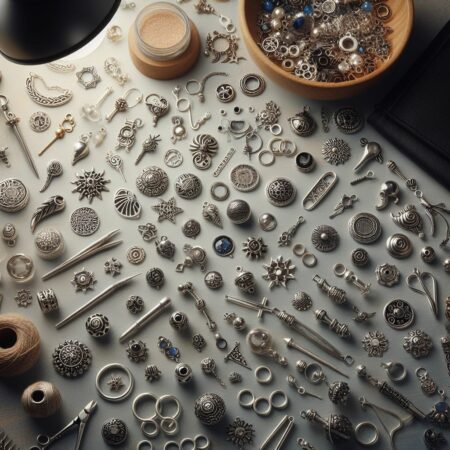Let’s talk about bead findings. Findings and clasps are added after the beads have been strung to complete the piece of jewelry so that it can be worn. These components help secure the necklace or bracelet and give it a polished look.
Most bracelets and necklaces require the insertion of rings and a clasp once the rope ends have been finished so that the item of jewelry may be easily placed on and taken off.
Xinar has been selling quality beads and bead findings for over two decades. We have the largest selection of the most beautiful findings in semi-precious metals, including sterling silver findings, gold-filled clasps and findings, copper clasps and findings, and rose gold-filled findings!
Essential Bead Findings: Bead Ends, Crimps, and Tips
To add a clasp, bead tips, crimps, and end caps are utilized to complete the ends of various stringing materials. Each cord end is made to function with a specific type of stringing material and diameter.
- Coil crimps are used with larger diameter cords like leather and satin cord, whereas bead tips are used with thin diameter cords like silk and waxed linen. Flat cords, such as suede, are typically used with fold-over crimps.
- Bead tips are used to conceal and hold knots at the end of strung or knotted jewelry and attach a clasp to the end of a strung item. Basket bead tips, which resemble little baskets with handles across the top, and clamshell bead tips, which resemble a clamshell with a hook at one end, are the two most frequent bead tips. The knot is entirely hidden by the clamshell bead tip, which closes over it.
- Crimp beads are tiny tube-shaped metal beads crimped over flexible beading wire to secure either end of a clasp. Crimp beads are available in various metals, sizes, and forms.
- Crimp covers are used to conceal crimp beads strung on flexible beading wire at the ends of a piece of jewelry. They are only for ornamental purposes and do not add to the strength of a piece of jewelry.
- Metal coils with a loop on the end that fits over and is attached to circular stringing materials are known as coil crimps. The loop ends are quickly joined with a clasp and a ring. Coil crimps are available in some metal hues to match clasps and other findings. They’re also available in various sizes to suit different diameters of circular cording.
- U-shaped metal findings with a loop on one end are fold-over crimps. These crimps have folded sides bonded to flat or circular stringing materials. Jump rings make it simple to attach a clasp to the fold-over crimp’s loop end. To match clasps and other findings, fold-over crimps are available in various metals.
- Ribbon crimps are metal findings that look like jaws and have a loop on one end. Teeth can be found on some ribbon crimps, whereas smooth jaws can be found on others. These crimps are clamped onto ribbon or other flat stringing materials, and they can be bonded in place for extra security.
- Glue-on ends conceal bulkier cord ends and create a smooth transition to a clasp. Bullet ends, end caps and barrel caps are all terms for glue-on lots. To make a clasp, glue the string into the end cap.
Functional Bead Findings: What Are Jewelry Clasps and Rings?
Each form of the ring has a specific purpose. As a result, they’re available in various metals, making them easy to match with the rest of your project’s metals. In addition, each ring type is available in various sizes and wire gauges.
- Jump rings are unsoldered, open rings that can be used to connect clasps, pendants, charms, and other components to a chain.
- Closed rings that can be utilized with crimped flexible beading wire, wire-wrapped components, or bead tips are soldered rings. The most secure ring is a soldered ring.
- Split rings are little key ring-shaped rings that fasten clasps and charms to chains and other rings.
- Clasps, like rings, come in a variety of forms, from simple spring rings and lobster claws to more specialized closures like tube and bar clasps. Choosing the best clasp for your project combines personal preference, design, and application.
- Box clasps consist of a box and a small, pressure-fitting component that snaps into the box. For added security, some box clasps incorporate tiny snap locks. This clasp works well on bracelets and necklaces. Box clasps are available in various sizes, shapes, decorative motifs, and metals.
- J-hooks are J-shaped metal components that join with soldered rings or jump rings on both ends. This clasp is most found on necklaces and is available in elaborate and straightforward forms. J-hooks are available in a variety of sizes, styles, and metals.
- Lanyard clasps are one-piece clasps with a flexible snap closure fashioned like a long droplet. This clasp is most commonly used on ID lanyards or leather or hemp jewelry designs. The majority of lanyard clasps are constructed of plated metals.
- Lobster claw clasps are a common choice for flexible beading wire and crimp beads, and they’re highly secure. They may be used to finish a jewelry item with almost any finding and stringing material. This claw-shaped lobster clasp is available in various sizes, patterns, and metals.
- Magnetic clasps are two-part clasps with powerful magnets holding them together. Lightweight jewelry and persons who have problems opening lobster claws or spring rings benefit from this clasp style. Magnetic clasps are available in various magnetic strengths, sizes, and types.
- Pearl clasps are oval-shaped clasps with filigree ornamentation that are highly classic. This clasp has a one-of-a-kind hook and snap closing ideal for necklaces. Pearl clasps were once only available in precious metals, but they are now accessible in various metals.
- S-hooks are S-shaped metal components that join with soldered rings or jump rings on both ends. These clasps are most commonly found on necklaces and are available in elaborate and straightforward versions. S-hooks are available in a limited number of sizes, styles, and metals.
- Spring rings have a spring-loaded barrel and are formed like a ring. This clasp is typically used with crimp beads and flexible beading wire. A spring ring can be used with almost any finding or stringing material. These clasps are available in a range of metals and sizes.
- A ring and a bar are used to make toggle clasps. The bar slides through it and then lies over it to shut the ring. This clasp is less secure than a lobster claw or spring ring, but it is frequently more user-friendly, particularly on bracelets. Toggle clasps come in a wide range of decorative designs and are commonly used as a design element in jewelry. These clasps are available in various sizes, styles, and metals.
- Tube and bar clasps often have a bar on one side and two, three, or five loops. The clasp comprises two components that fit together and snap together. Magnetic clasps are available in some variants of these clasps for increased security. Metals are used to create tube and bar clasps.
Exploring Spacers, Caps, and Cones
Caps can disguise ugly bead holes, cones can conceal the ends of a multistrand creation, and spacers can add glitter and complexity to a bracelet or necklace. But, of course, caps, cones, and spacers can also be purely decorative design elements.
Caps are half-sphere–shaped decorative fittings that fit over bead holes to hide the opening or contribute to the piece’s design. They are available in various patterns, sizes, and metals, ranging from plated to precious.
Cones are ornamental conical findings that hide numerous strands of beads attached to a single clasp. They are available in various patterns, sizes, and metals, ranging from plated to precious.
Spacer beads are little decorative pieces that come in various sizes, shapes, and patterns. A spacer bead is a flat bead with a hole in the center that serves as a design element between round or shaped beads. They’re utilized to give any stringed project more intrigue, shine, and pattern.
Spacer bars are utilized with bar ends to construct tidy and orderly multistrand projects. In addition, the bars assist keep the strands in place when wearing the item and keeping it flat.
Spacer bar ends are utilized to convert numerous strands down to one to make it easier to affix a clasp. With or without spacer bars, bar ends can be employed.






